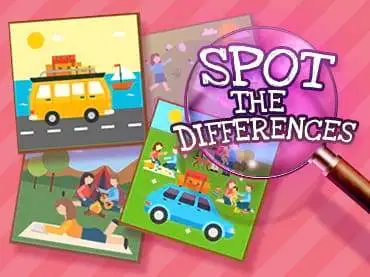Spot the differences in the vast landscape of casual games, “Spot the Differences” stands out as a timeless and universally loved genre. Originating from classic puzzle books and newspapers, this interactive game has seamlessly transitioned into the digital age, captivating players of all ages. As we embark on a journey through the captivating world of “Spot the Differences” games, we’ll explore the history, the evolution of gameplay, the impact of technology, and the enduring appeal that keeps enthusiasts coming back for more.
Contents
- 1 A Walk Down Memory Lane: The Origins of “Spot the Differences” Games
- 2 Digital Evolution: Bringing “Spot the Differences” to the Screens
- 3 The Appeal of “Spot the Differences”: Unveiling the Allure
- 4 Technology and Innovation: Transforming the Gameplay Experience
- 5 Educational Value: Learning Through Observation
- 6 Spot the Differences Beyond Screens: Offline Games and Educational Applications
- 7 The Future of “Spot the Differences” Games: Integrating Technology and Education
- 8 Conclusion
A Walk Down Memory Lane: The Origins of “Spot the Differences” Games
The roots of “Spot the Differences” games can be traced back to the early 18th century when puzzle books and periodicals started incorporating visual challenges. These challenges often featured illustrations with subtle alterations, encouraging readers to keenly observe and identify the discrepancies. The simplicity and accessibility of these puzzles made them an instant hit, becoming a staple in newspapers and magazines across the globe.
In the pre-digital era, “Spot the Differences” games served as an engaging pastime for individuals looking to unwind and challenge their observational skills. The analog format, however, had its limitations, with static images and a finite number of puzzles per publication.
Digital Evolution: Bringing “Spot the Differences” to the Screens
The advent of digital technology catapulted “Spot the Differences” games into a new era of accessibility and interactivity. With the rise of personal computers and, later, mobile devices, game developers seized the opportunity to create dynamic, visually stunning, and endlessly replayable versions of the classic puzzle.
The transition to digital platforms brought forth several notable changes:
- Dynamic Images and Themes: Digital “Spot the Differences” games introduced a vast array of themes, ranging from picturesque landscapes and bustling cityscapes to whimsical illustrations and pop culture references. This diversity not only enhanced the visual appeal but also broadened the demographic appeal of the games.
- Interactivity and Animation: Unlike their static predecessors, digital games embraced interactivity and animation. Players could now tap, swipe, or click on the screen to highlight differences, adding an extra layer of engagement to the experience. Animated elements also became integral to the gameplay, making the identification of differences more challenging and entertaining.
- Infinite Puzzles: The digital realm facilitated the creation of an extensive database of puzzles, ensuring that players never ran out of challenges. Developers could regularly update content, introducing new images and variations, keeping the gameplay fresh and exciting.
The Appeal of “Spot the Differences”: Unveiling the Allure
The enduring popularity of “Spot the Differences” games can be attributed to a combination of factors that make them universally appealing:
- Accessible Gameplay: One of the key strengths of “Spot the Differences” lies in its simplicity. The rules are straightforward – find the discrepancies between two images. This accessibility makes it suitable for players of all ages and skill levels, from children honing their observation skills to adults seeking a relaxing diversion.
- Cognitive Engagement: Beyond its simplicity, the game offers a subtle yet effective cognitive workout. Players must engage their visual perception, memory, and attention to detail to successfully identify the differences. This mental stimulation adds an educational component to the entertainment, making it a preferred choice for parents and educators.
- Stress Relief and Relaxation: “Spot the Differences” games provide a delightful escape from the demands of daily life. The focused yet gentle concentration required by the game creates a meditative experience, offering a moment of respite from stress and anxiety. The calming nature of the game contributes significantly to its widespread popularity as a stress-relief tool.
- Variety of Themes: The diversity of themes and images in “Spot the Differences” games caters to a broad audience. Whether players are drawn to nature, art, or popular culture, there’s a plethora of options to suit individual preferences. This versatility ensures that the game remains engaging and relevant across different demographics.
Technology and Innovation: Transforming the Gameplay Experience
As technology continues to advance, “Spot the Differences” games evolve with it, incorporating innovative features and enhancing the overall gameplay experience:
- Augmented Reality (AR) Integration: Some contemporary “Spot the Differences” games leverage AR technology to provide an immersive and interactive experience. Players can use their smartphones or AR devices to superimpose the game onto their physical surroundings, blurring the lines between the virtual and real worlds.
- Multiplayer and Social Connectivity: Social connectivity has become a key aspect of many digital games, and “Spot the Differences” is no exception. Multiplayer modes, online leaderboards, and the ability to share scores and achievements on social media platforms enhance the social aspect of the game, fostering a sense of community among players.
- Adaptive Difficulty Levels: To cater to a diverse audience, modern games often incorporate adaptive difficulty levels. This ensures that players are continually challenged, irrespective of their skill level. The game dynamically adjusts the complexity of puzzles based on the player’s performance, offering a personalized and engaging experience.

Educational Value: Learning Through Observation
While “Spot the Differences” games are primarily associated with entertainment, they also possess educational value, especially for younger players. The game promotes and enhances several cognitive skills:
- Visual Discrimination: Players must discern minute differences between seemingly identical images, honing their visual discrimination skills. This ability is crucial for tasks that require attention to detail, such as reading and problem-solving.
- Attention to Detail: The game encourages players to pay close attention to the details of each image. This heightened attention to detail can translate into improved focus in academic and professional settings.
- Memory Enhancement: Successfully identifying differences often requires the ability to remember details from one image and compare them to another. This memory enhancement aspect of the game contributes to overall cognitive development.
- Problem-Solving Skills: Analyzing and identifying differences is a form of problem-solving. Players must use logic and deduction to find the variations, fostering critical thinking skills.
Spot the Differences Beyond Screens: Offline Games and Educational Applications
While digital versions of “Spot the Differences” dominate the gaming landscape, the appeal of this genre extends to offline formats and educational applications:
- Printed Puzzle Books: The charm of “Spot the Differences” extends to traditional printed puzzle books. These books, often found in bookstores and supermarkets, provide a tangible and portable form of the game. The tactile engagement of flipping through pages and circling differences with a pen adds a nostalgic touch to the experience.
- Educational Apps for Children: Recognizing the educational potential of “Spot the Differences,” developers have created apps specifically designed for children. These apps often incorporate vibrant visuals, interactive elements, and age-appropriate themes to make learning enjoyable for young players.
- Classroom and Training Exercises: “Spot the Differences” games find application in educational settings, where they serve as engaging exercises for students. Teachers use customized versions of the game to reinforce lessons, stimulate critical thinking, and promote teamwork among students.
The Future of “Spot the Differences” Games: Integrating Technology and Education
Looking ahead, the future of “Spot the Differences” games holds exciting possibilities, especially in the realms of technology integration and educational applications:
- virtual reality (VR) Experiences: As VR technology continues to advance, “Spot the Differences” games may enter a new dimension of immersive gameplay. VR headsets could transport players into virtual environments where they must explore and identify differences in three-dimensional spaces, creating a more engaging and interactive experience.
- Artificial Intelligence (AI) Enhancements: The integration of AI into “Spot the Differences” games could revolutionize the genre. AI algorithms could generate puzzles dynamically based on a player’s preferences and skill level, ensuring a personalized and continuously challenging experience. Additionally, AI could analyze player behavior to adapt and optimize the gaming environment in real-time.
- Cross-Platform Accessibility: The future may see increased cross-platform accessibility, allowing players to seamlessly transition between devices. A player could start a game on a smartphone during a commute, continue on a tablet at home, and conclude on a computer—all while maintaining progress and achievements.
- Gamification in Education: As educational institutions increasingly embrace gamification, “Spot the Differences” games may find a permanent place in classrooms. Customized educational versions could be designed to align with specific curriculum objectives, making learning more engaging and enjoyable for students.
- Collaborative and Competitive Gameplay: Future iterations of “Spot the Differences” games may emphasize collaborative and competitive elements. Multiplayer modes could involve teamwork to identify differences collectively, fostering communication and cooperation. Competitive aspects, such as timed challenges and real-time leaderboard updates, may heighten the thrill of the game.
Conclusion
“Spot the Differences” games have transcended generations and technological shifts, maintaining their popularity by striking a balance between simplicity and engagement. From humble beginnings in print media to the immersive digital experiences of today, the genre continues to captivate players worldwide.
The enduring allure of “Spot the Differences” lies in its ability to seamlessly blend entertainment and education. Whether played for relaxation, cognitive stimulation, or as a shared activity among friends and family, the game persists as a testament to the timeless joy of observation.
As technology continues to advance, the future promises even more innovative and interactive experiences within the “Spot the Differences” genre. Whether through augmented reality, artificial intelligence, or cross-platform accessibility, the essence of the game’s sharp observation will remain at its heart, ensuring its place in the digital gaming landscape for years to come. So, the next time you embark on a journey to spot those elusive discrepancies, remember that beyond the pixels and puzzles, you are engaging in a timeless activity that celebrates the joy of keen observation and the thrill of discovery.
